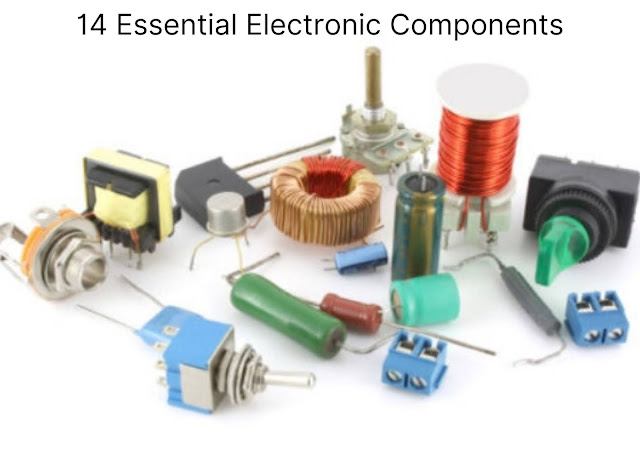14 basic electrical components and their functions
To summaries the world of electronic components, a simple list of elements might be utilized. Here's where you can learn more about these key components of modern electronics. What are the electronic components? Some of the most frequent components found in electronic gadgets are as follows:
What are the applications of electronic components? Microcomputers are miniature computers that are used to control a wide range of devices including power tools, remote controls, medical equipment, and office machines. Chemical energy is transformed into electrical energy by battery. Anode (+) and cathode (-) are the two primary components in a battery (-).
Also see: sensors wholesale suppliers in India
Fuses prevent components from being overloaded with too much current. A fuse is made up of a connection body, a support, contacts, and a metal fuse substance like zinc or copper. A circuit breaker can be controlled using a remote switch as a safety precaution. Its purpose is to prevent the circuit from being overloaded or short-circuited.
Current is interrupted by switches. Single pole single throw (SPST), single pole double throw (SPDT), double pole single throw (DPST), and double pole double throw (DPDT) are the four types of switches (DPDT).
Current is interrupted by switches. Single pole single throw (SPST), single pole double throw (SPDT), double pole single throw (DPST), and double pole double throw (DPDT) are the four types of switches (DPDT).
Relays are electromechanical switches that turn on and off electricity. An electromagnet, an armature, a set of electrical contacts, and a spring make up a relay.
Electrical energy into mechanical energy by motors. A rotor, stator, bearings, conduit box, enclosure, and eye bolt are all important components. Motors can power a wide range of items, from watches to home entertainment systems to vehicles.
In electronics, what are active and passive components? Transistors are active components, while transformers, inductors, resistors, and capacitors are passive components. Transformers are frequently used to increase or decrease power. A resistor limits the amount of current that can flow through it. Thermistors and potentiometers contain it. A capacitor, like a low-capacity battery, allows circuit delays to occur. Frequencies are controlled via inductors.
When building electrical circuits, you’ll use resistors, capacitors, diodes, transistors, inductors, and integrated circuits, among other basic electronic components. The components and their functions are summarized below.
A resistor is one of the components included in an integrated circuit. The gadget, as its name implies, opposes current flow. Power ratings (the amount of power they can handle without exploding) and resistance values are used to grade resistors (capacity to resist current). Ohms are the units used to measure resistance. The unit’s electronic symbol is O.
Capacitors are components that may temporarily store electric charge. The components come in a variety of shapes and sizes, with electrolytic and ceramic disc being the most prevalent. Microfarads (F) are commonly used to assess a component’s capacity.
Diodes are devices that allow electric current to flow in just one direction. The anode and cathode are the two terminals of each diode. Electric current can flow when the anode is charged with positive voltage and the cathode is charged with negative voltage. The current will not flow if these voltages are reversed.
Transistors are easily identified by their three terminals. Voltage must be applied to one of the components, the base terminal, in order for it to function. The base can then control the flow of current in the other two terminals (the emitter and collector).
Inductors are energy-storing passive components that store energy as a magnetic field. An inductor is basically a coil of wire wound around a core of some sort. A magnet or air could be used as the core. A magnetic field is formed around the inductor when current passes through it. When a magnet is utilized as the core, the magnetic field is amplified.
Integrated Circuits: An integrated circuit is a particular device that contains all of the electronic circuit’s components. Diodes, transistors, and other devices are all etched on a tiny piece of silicon in this component. Many electrical devices, including watches and computers, employ the components.
Microcontrollers are small computers that are used to control a wide range of devices, including power tools, remote controls, medical equipment, and office machines.
Microcontrollers are small computers that are used to control a wide range of devices, including power tools, remote controls, medical equipment, and office machines.
Transformers are widely used to step up or down power and are made up of two coils of wire.
Chemical energy is converted to electrical energy by batteries. Anode (+) and cathode (-) are the two types of cells in a battery (-).
Chemical energy is converted to electrical energy by batteries. Anode (+) and cathode (-) are the two types of cells in a battery (-).
Fuses: Fuses protect components from excessive current overloading. The connection body, support, contacts, and metal-fuse material, such as zinc or copper, make up a fuse.
Relays are electromechanical switches that turn on and off power. An electromagnet, an armature, a set of electrical contacts, and a spring make up a relay.
Switches are devices that interrupt current flow. Single pole single throw (SPST), single pole double throw (SPDT), double pole single throw (DPST), and double pole double throw (DPDT) are the four types of switches (DPDT).
Electrical energy is converted into mechanical power by motors. A rotor, stator, bearings, conduit box, enclosure, and eye bolt are all important electronic components.
Circuit Breakers: A circuit breaker can be controlled using a remote switch as a protective measure. Its purpose is to prevent the circuit from being overloaded or short-circuited.
Related links:




Comments
Post a Comment